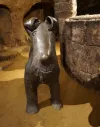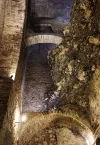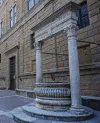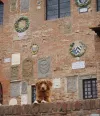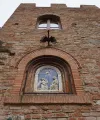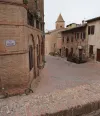Four hilltop towns
- 21 April 2022
- Prue Scott
Montepulciano is famous for its wine, its medieval and Renaissance hill town, and its Etruscan origins.
Pienza is a World Heritage site, does a nice line in pecorino and, like Montepulciano, sits atop a hill.
Certaldo is home to the family of Giovanni Boccaccio, author of the Decameron, with the lower and upper towns linked with a short and very steep funicular railway.
Volterra dates to Neolithic times and was part of the Etruscan civilisation, complete with Roman baths, an aqueduct and amphitheatre.
These four, and many more, are mainstays of the tourist trails and can be wall-to-wall people at the height of the season. The solution? Go now.
“Gio has three spaces in the van on Sunday for Montepulciano and Pienza,” said Patricia. I need no more incentive than that, and off we went.
Gio – also Giovanni and Joe and a few others – is a Napoletana who spent time in Florida and returned with his wife Loreal to start The Tuscan Wanderer guided tours business. A few months later, Covid-19 shut everything down. But they’ve come through it and are now in business with a most comfy black Mercedes van (automatic doors!).
We all introduce ourselves. Where do you come from? Do you live here? How long are you staying? Where are you living in Lucca? These are the standard questions when you meet non-Italians. Americans Gary and Ilene have retired here; Marianna and Olga are on holiday from the States; Lois is an American who’s just signed the lease on apartment and is organising her life so she can fly between Italy and the States with just a cabin bag.
At Montepulciano, we turn off for a trip into a valley which is the home of Pulcino, once a friary and now a vino rosso biologique - aka organic wine. We arrive at noon, rather early for a Tuscan lunch, but the huge room is soon full to bursting with couples, family groups and a dozen or so leathered-up motorbike riders.
Italy is known for its antipasto, but there’s another variation – the tagliere. Literally, the chopping board or platter on which is a range of cured meats. It’s paired with two of Pulcino’s wines – one young (needs a few more years) and a 2011 which was good. La signora tried to sell me a bottle of the 2011 for €85, but even when she came down to €50, I wasn’t buying.
We shouldn’t have eaten the tagliere with such gusto because the main course was sliced beef a la Fiorentina from a steak the size of a plate and about 5cm thick, and chicken, both cooked over a massive grill at the front of the building.
Their cellar, full of tubby casks doing what casks do, is a constant 8C all year round.
We left for the town, fortified by vin santo and head-numbing espresso. Montepulciano sits atop ancient cellars lined with brick and full of fat wine casks, some holding thousands of litres. De ‘Ricci is based in the old Palazzo Ricci and one descends deep into the hillside to marvel at the casks, the engineering feat of these massively high cellars and a world-class art collection. Our host, Belgian as I recall, was deft; he talked as though he’d never given this tour before. I do appreciate the skill.
Pienza in the late afternoon featured an icy wind, the sort that comes straight up off snow. Yes, we were on a hilltop, but that was a very nippy hour or so as we roamed around streets and squares of golden stone beneath that intense blue Tuscan sky. We resisted the charms of the pecorino shop with wheels wrapped in leaves, herbs, straw, or peppercorns. Pecorino is freely available and why pay tourist prices?
On that subject. Tourism isn’t always a way of life for these towns, but it does bring in good money. You need to be careful about what you buy. Is that truffle paste really made here? What about that linen tea towel printed with brightly coloured wine glasses? Yes, Italy produces linen, but the quality is highly variable. “Genuine Tuscan pottery” may well be genuine, but possibly not from a husky Tuscan throwing clay on a wheel.
How about Certaldo and Volterra on Sunday with lunch along the way? Why not, and once again I’m off with Gio, Marianna, Olga and Lois, and a few new faces to get another fill of Tuscany – fortified hilltop towns of stone that turns gold in the sinking sun, roads lined with cyprus trees (the roads of white gravel are called “strada bianca”), olive trees, vines (just sticks at the moment but another few weeks they’ll be covered in fresh green leaves). Here and there, discreet signs indicate hugely expensive lodgings of the sort with year-round pools.
Certaldo. I took far too many photos and would be hard-pressed to tell them apart from the other hill towns. What makes you look at each town carefully is the detail – a mural here, a shield there, an old metal lock, the remains of an ancient fresco. Each town has its variations and that’s what makes them stand out.
Certaldo Basso (the lower town) is your standard town; Certaldo Alto (the higher town) is the one you want to see and you reach it by a short and steep funicular.
We drove far into the countryside, up and down hill, around steep bends and through exquisite scenery. Gio had heard about this restaurant and thought we might like it.
Italian restaurants cope well with groups. A table of eight or 16 who chop and change their orders is quite normal, and it’s all handled with great grace. Yes, pasta with sauce is easy, but they’re still juggling to serve everyone at the same time. They do it well, whether it’s a fattoria (farm restaurant like Pulcino) or one tucked into the side of a tiny square in Mazzola – Trattoria Albana.
Those of you who know the Steve Coogan/Rob Brydon films of “The Trip” series will recognise the name from the “The Trip to Italy”. To be honest, it looks like a local café in a tiny – and I mean tiny – town and you’d not give it a look. Big mistake. I devoured the wild boar ragu on fresh pappardelle before we piled back into the van and headed to Volterra….
…in time to see the new Cardinal being welcomed. Italy loves a parade and as we came down the steps to the square, people in costume paraded past to the sound of trumpets and drums.
On the way home, Gio casually mentioned the boats were already running up the Cinque Terre coast….and my mind immediately began planning another trip.
It’s Italy – so much to see.




